A Look At Triple-GPU Performance And Multi-GPU Scaling, Part 1
by Ryan Smith on April 3, 2011 7:00 AM ESTCrysis, BattleForge, Metro 2033, and HAWX
For the sake of completeness we have included both 2560x1600 and 1920x1200 results in our charts. However with current GPU performance a triple-GPU setup only makes sense at 2560, so that’s the resolution we’re going to be focusing on for commentary and scaling purposes.
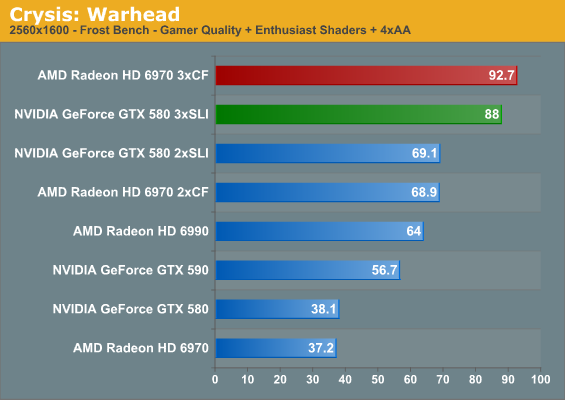
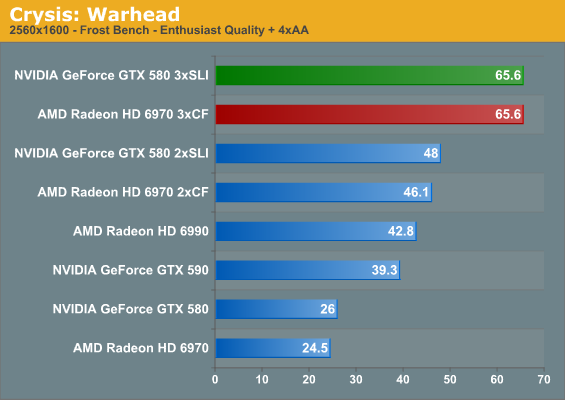


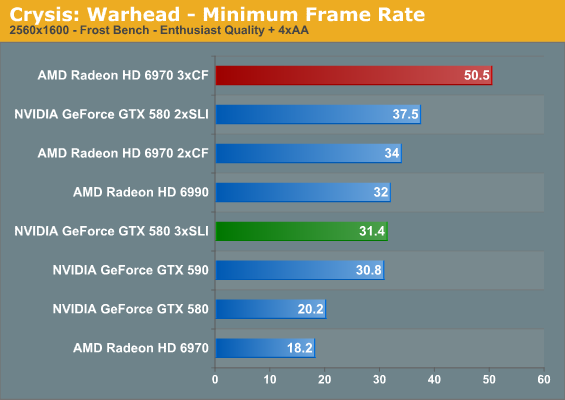

As we normally turn to Crysis as our first benchmark it ends up being quite amusing when we have a rather exact tie on our hands. The triple GTX 580 setup ends up exactly tying the triple 6970 setup at 2560x1600 with full enthusiast settings at 65.6fps. This is quite an appropriate allegory for AMD and NVIDIA’s relative performance as of late, as the two are normally very close when it comes to cards at the same price. It’s also probably not the best start for the triple GTX 580 though, as it means NVIDIA’s lead at one and two cards has melted away by the 3rd.
We have however finally established what it takes to play Crysis at full resolution on a single monitor with every setting turned up – it takes no fewer than three GPUs to do the job. Given traditional GPU performance growth curves, it should be possible to do this on a single GPU by early 2014 or so, only some 7 years after the release of Crysis: Warhead. If you want SSAA though, you may as well throw in another few years.
Moving on, it’s interesting to note that while we had a tie at 2560 with Enthusiast settings for the average framerate, the same cannot be said of the minimums. At 2560, no matter the quality, AMD has a distinct edge in the minimum framerate. This is particularly pronounced at 2560E, where moving from two to three GPUs causes a drop in the framerate on the GTX 580. This is probably a result of the differences in the cards’ memory capacity – additional GPUs require additional memory, and it seems the GTX 580 and its 1.5GB has reached its limit. We never seriously imagined we’d find a notable difference between 1.5GB and 2GB at this point in time, but here we are.
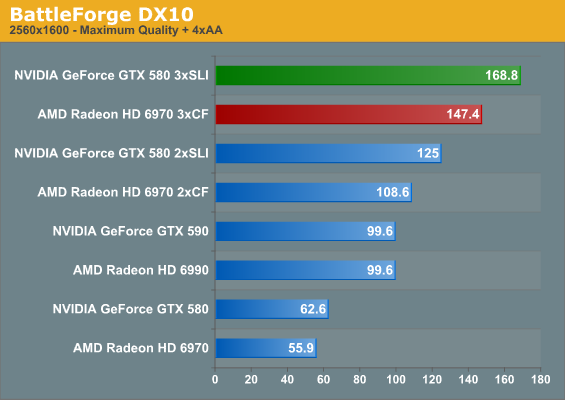
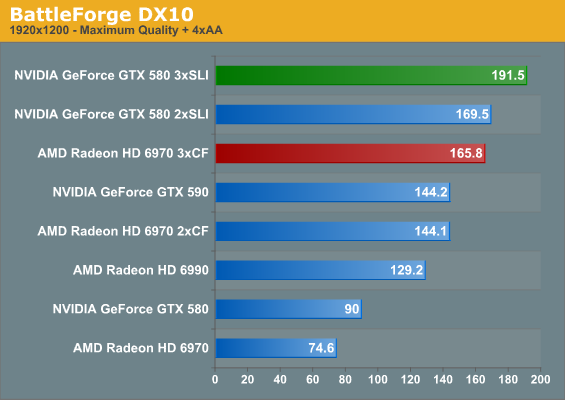
BattleForge is a shader-bound game that normally favors NVIDIA, and this doesn’t change with three GPUs. However even though it’s one of our more intensive games, three GPUs is simply overkill for one monitor.

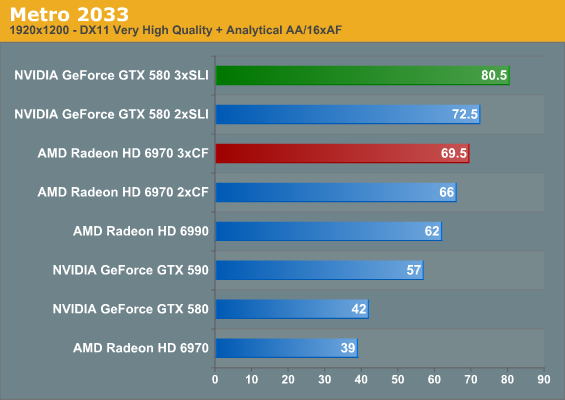
Metro 2033 is the only other title in our current lineup that can challenge Crysis for the title of the most demanding game, and here that’s a bout it would win. Even with three GPUs we can’t crack 60fps, and we still haven’t enabled a few extra features such as Depth of Field. The 6970 and GTX 580 are normally close with one and two GPUs, and we see that relationship extend to three GPUs. The triple GTX 580 setup has the lead by under 2fps, but it’s not the lead one normally expects from the GTX 580.
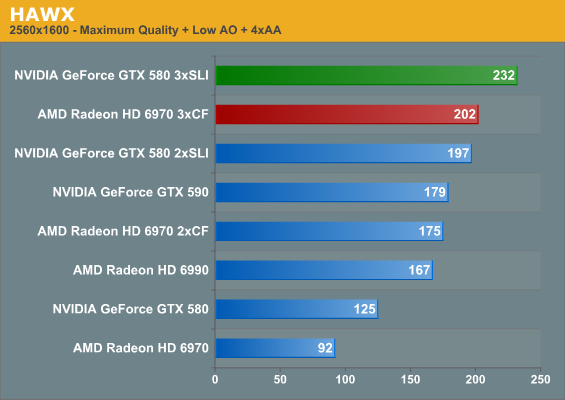

Our next game is HAWX, a title that shifts us towards games that are CPU bound. Even with that it’s actually one of the most electrically demanding games in our test suite, which is why we use it as a backup for our power/temperature/noise testing. Here we see both the triple GTX 580 and triple 6970 crack 200fps at 2560, with the GTX 580 taking top honors.
| Radeon HD 6970 | GeForce GTX 580 | |||||
| GPUs | 1->2 | 2->3 | 1->3 | 1->2 | 2->3 | 1->3 |
| Crysis G+E Avg |
185%
|
134%
|
249%
|
181%
|
127%
|
230%
|
| Crysis E |
188%
|
142%
|
268%
|
184%
|
136%
|
252%
|
| Crysis G+E Min |
191%
|
141%
|
270%
|
181%
|
116%
|
212%
|
| Crysis E Min |
186%
|
148%
|
277%
|
185%
|
83%
|
155%
|
| BattleForge |
194%
|
135%
|
263%
|
199%
|
135%
|
269%
|
| Metro 2033 |
180%
|
117%
|
212%
|
163%
|
124%
|
202%
|
| HAWX |
190%
|
115%
|
219%
|
157%
|
117%
|
185%
|
Having taken a look at raw performance, what does the scaling situation look like? All together it’s very good. For a dual-GPU configuration the weakest game for both AMD and NVIDIA is Metro 2033, where AMD gets 180% while NVIDIA manages 163% a single video card’s performance respectively. At the other end, NVIDIA manages almost perfect scaling for BattleForge at 199%, while AMD’s best showing is in the same game at 194%.
Adding in a 3rd GPU significantly shakes things up however. The best case scenario for going from two GPUs to three GPUs is 150%, which appears to be a harder target to reach. At 142% under Crysis with Enthusiast settings AMD does quite well, which is why they close the overall performance gap there. NVIDIA doesn’t do as quite well however, managing 136%. The weakest for both meanwhile is HAWX, which is what we’d expect for a game passing 200fps and almost assuredly running straight into a CPU bottleneck.
The Crysis minimum framerate gives us a moment’s pause though. AMD gets almost perfect scaling moving from two to three GPUs when it comes to minimum framerates in Crysis, meanwhile NVIDIA ends up losing performance here with Enthusiast settings. This is likely not a story of GPU scaling and more a story about GPU memory, but regardless the outcome is a definite hit in performance. Thus while minimum framerate scaling from one to two GPUs is rather close between NVIDIA and AMD with full enthusiast settings and slightly in AMD’s favor with gamer + enthusiast, AMD has a definite advantage going from two to three GPUs all of the time out of this batch of games.
Sticking with average framerates and throwing out a clearly CPU limited HAWX, neither side seems to have a strong advantage moving from two GPUs to three GPUs; the average gain is 131%, or some 62% the theoretical maximum. AMD does have a slight edge here, but keep in mind we’re looking at percentages, so AMD’s edge is often a couple of frames per second at best.
Going from one GPU to two GPUs also gives AMD a minor advantage, with the average performance being 186% for for AMD versus 182% for NVIDIA. Much like we’ve seen in our individual GPU reviews though, this almost constantly flip-flops based on the game being tested, which is why in the end the average gains are so close.










97 Comments
View All Comments
Ryan Smith - Sunday, April 3, 2011 - link
I am not highly sensitive to microstuttering (aliasing on the other hand...). In my experience nothing here microstuttered, and the only thing that performed poorly was the NV 3xGTX580 setup under Bad Company 2.james.jwb - Sunday, April 3, 2011 - link
Ryan, do you think you could re-run just a single game (you choose) but with the CPU overclocked to 4.0Ghz or higher if you can (4.5ghz if possible). 3 GPU's will surely react well to this, I'd love to see the results (for 2x, too).james.jwb - Sunday, April 3, 2011 - link
just at 2560 btw :)DanNeely - Sunday, April 3, 2011 - link
Ryan posted elsewhere that the 920 he's using is from the slow end of the bell curve and isn't stable above 3.33; so until he gets a new system this is as good as it gets.PhantomKnight - Sunday, April 3, 2011 - link
This is not the only way. There are flexible PCIe cables around on eBay. I don't know how well they would work, but it would be possible to use something like this to increase the room around the cards. http://cgi.ebay.com.au/PCI-E-PCI-Express-16X-Riser... ETC7Enigma - Tuesday, April 5, 2011 - link
Interesting. I wonder if this would harm latency somehow (or reduce the amount of power the PCIe slot can supply due to essentially using an extension cord for the gpu).masterkritiker - Sunday, April 3, 2011 - link
While it is a great article, sadly it's a limited one. The dual/triple GPU test should have been done across multiple platforms, x58/890FX/P67 regardless of some platform limited pcie lanes like the P67. Let's be honest SNB systems are the ones selling like mad right now, you'll hardly convince more people w/ an x58 system to spend money upgrading their GPU to dual/triple GPUs while SNB-E is just around the corner & their x58 systems are still great for them. Trust me people will "wait"! The test could have efficiently validated anyone deciding to upgrade from single to dual/triple GPUs across multiple platforms in either a single 1080p/1600p monitor or even multiple monitors, I guess we have to wait for the test(If that will happen).b1u3 - Monday, April 4, 2011 - link
2x590GTX vs 2x6990...ypsylon - Monday, April 4, 2011 - link
Frankly I can't get my head around this test. If you have ~2000$ to blow on 3 VGAs then there is good chance you will buy 2x590* or 2x6990. It is more logical and convenient choice.Performance by a tiny fraction lower vs 3xSLI/CF (at worst - only with reference - under-clocked - models currently available), but you'll need only 2 cards, not 3. Easier to implement, less clutter inside, and if by any chance you own a motherboard with 3* slot space between 1st and 2nd x16 slot then it is absolute win-win.
piroroadkill - Monday, April 4, 2011 - link
Quite. I don't know why 6990 CF, just like 5970 CF, was almost completely ignored by AnandTech..